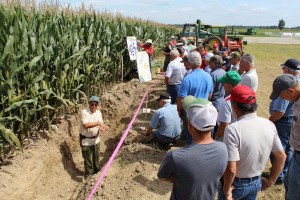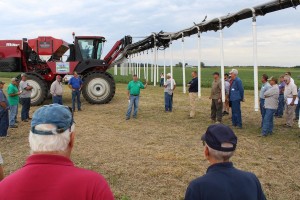MARION, Ohio — You probably would expect the speakers at a no-till conference to support the benefits of no-till.
And, that was definitely the case among the farmers and scientists who attended the Ohio no-till field day Sept. 9, at John Buck’s Marion County Farm.
But no-till alone is just the beginning of a healthy system, and there is a major “quality” difference depending on how the farmer handles his no-till.
“If we quit doing the tillage, that is going to help heal the soil, but it’s not going to really improve it that much,” said Hans Kok, coordinator for Indiana Conservation Cropping Systems.
Quality no-till
Kok said the focus should be “quality” no-till, which means using cover crops, buffer strips, crop rotation and paying attention to detail.
He said farmers today are not farming as good of soil as their grandparents did, because of all the tillage over the past several decades. The tillage — especially over-tillage — results in fewer earthworms, and more soil bacteria, which he said affects the soil structure and the ability of soil particles to hold together.
He said he understands why farmers are reluctant to give up tillage. For one thing, tillage has been the norm for a long time, and it also requires a lot of horsepower and big tractors — two things farmers usually like.
Kok said he, too, loves big tractors and black smoke. But he said it’s also like an addiction — one farmers “need to get off of.”
Big equipment
But making the change to no-till doesn’t necessarily mean giving up the fun of running big machines.
“There’s some awesome tools out there that still need big tractors that make the smoke roll, but yet they don’t tear up the soil so bad,” he said.
For instance — large-scale precision planters — as well as harvest equipment, and manure and nutrient application equipment.
There are many benefits with no-till, but the biggest gain is that it disturbs the soil less. When it’s less disturbed, natural systems take over and usually create a better soil structure and more ideal growing conditions.
Earthworms become more prevalent, which leads to more burrows in the soil, and also more nutrients being carried and deposited deeper into the soil.
“They (earthworms) do great things for our soil,” Kok said. “You start disturbing their habitat and they’re not going to do great things.”

One of the things they do, as shown during the field day, is drag crop residue such as old corn fodder, deeply into their burrows. This helps break down the residue and also gets the residue into the soil — without the farmer having to turn the soil over.
Kok said earthworms can live in the same burrow for as long as eight years, if they’re undisturbed. The burrows not only loosen the soil, but also provide channels for crop roots to shoot down, as the crop is growing.
Many benefits
Barry Fisher, state agronomist with Indiana NRCS, said no-till systems where cover crops are used can capture a great amount of carbon and build carbohydrates for future plants — but just one year of tillage will pretty much eliminate all that is retained.
“You can’t hardly grow (and capture) enough carbon that one year of tillage won’t eliminate,” he said.
Another benefit of no-till is that it helps reduce compaction. Fisher said farmers often think of compaction as the consequence of driving heavy equipment across the field — which can happen — but he said the first form of compaction comes from “aggregate instability,” in which the soil particles bust apart from the impact of rain.
The soil structure falls apart and plugs any available burrows and channels, and the soil quickly becomes less porous and less able to retain nutrients and overall structure.
Farmers got to see the benefits of no-till and cover crops up close during the field portion of the day. Field plots showed how far different cover crop roots penetrate, with some going considerably deeper than others.
This is why experts often recommend a mix of cover crop seeds — because each seed specie has a different set of traits, that when combined, produce favorable results. Cover crops are also a good way of capturing energy from the sun, which transfers nutrients into the soil after the primary crop has been harvested.
Overcoming challenges
While farmers have known about cover crops for many years — they’ve also battled some of the same challenges — like finding time to plant them after harvest, and worrying if the cover crop will have enough time to get established before winter, and die back in the spring, so that it doesn’t compete with the primary crop.
One way farmers have been able to lengthen the growing season for cover crops is by seeding while the primary crop is still growing. This is often done with an airplane, but in recent years has been accomplished with various types of interseeders, that allow for planting between the rows of standing crops.
Getting creative
Representatives from Buckeye Soil Solutions in northwestern Ohio brought a field sprayer equipped with a cover crop planting mechanism, that deposits cover crop seeds between the rows of corn or soybeans, at a seed drop speed of about 130 mph.

The company does custom planting and also retrofits existing sprayers to be capable of planting cover crops. The high-boom clearance of a sprayer allows for planting in tall crops, like corn, with about a 1 percent damage to the existing crop — and sometimes less.
A big concern over planting cover crops into existing crops is making sure the cover crop gets enough sunlight to get established. For this reason, Buckeye Soil typically waits until about 25 percent of the primary crop begins to yellow — which signals drydown and allows more sunlight to reach the cover crop.
The field day was hosted by John Buck, a grain farmer and consultant.with TurnKey Leadership Group.











Great summary article. I learned a lot about better no-till planting.